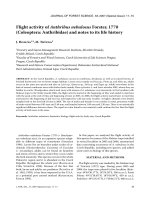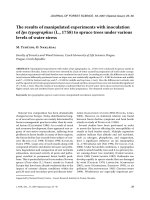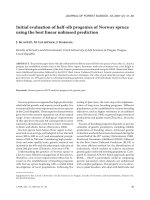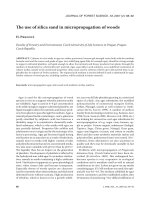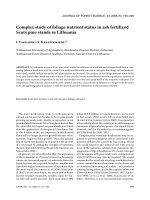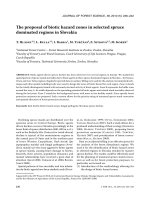Báo cáo lâm nghiệp: "Spatial distribution of four spruce bark beetles in north-western Slovakia" pps
Bạn đang xem bản rút gọn của tài liệu. Xem và tải ngay bản đầy đủ của tài liệu tại đây (420.3 KB, 8 trang )
J. FOR. SCI., 53, 2007 (Special Issue): 45–52 45
JOURNAL OF FOREST SCIENCE, 53, 2007 (Special Issue): 45–52
Spatial distribution of four spruce bark beetles
in north-western Slovakia
M. T
1
, T. H
2
1
Faculty of Forestry and Wood Sciences, Czech University of Life Sciences Prague,
Prague, Czech Republic
2
Department of Ecology and Biodiversity of Forest Ecosystems, National Forest Centre
– Forest Research Institute, Zvolen, Slovakia
ABSTRACT: Infestation density of four the most common spruce bark beetle species was estimated on 15 study sites
(10 trees per site) in the Kysuce model region in 2006. Five half-metre long sections of the stem were selected and
dissected at the base of the stem; midway between the base of the stem and the base of the crown; just below the base
of the crown; in the middle of the crown; and in the upper part of the crown. e infestation density of bark beetles,
expressed as the number of mating chambers per dm
2
, was determined. Ordinary kriging was then used to produce
smooth maps and visualize spatial distribution of study species. Maps with isolines indicating high infestation were
produced for study species (I. typographus over 0.38; I. amitinus over 0.15; I. duplicatus over 0.11; and P. chalcographus
over 0.415 nuptial chambers per dm
2
). Ips typographus L. remained dominant species on majority of sites having high
intensity of infestation. Lower altitudes in the south-eastern part of the region were often infested by I. duplicatus
Sahlberg and also by I. typographus and Pityogenes chalcographus L. Higher elevations in the north-eastern part of
territory in the vicinity of border with Poland were heavily infested by I. amitinus Eichhoff (often with I. typographus).
P. chalcographus was abundant on majority of territory – mainly in southern half of area. However locally, it was
found in extremely high abundance. e results suggest the need for control measures set up jointly against the most
abundant bark beetle species in study region.
Keywords: bark beetles; infested spruces; spatial distribution; kriging
In the last centuries, natural forests in Central Eu-
rope have been heavily converted to spruce mono-
cultures what resulted in several million m
3
of trees
infested annually by spruce bark beetles (T,
N 1998; K, Z 2006). In such
conditions, the pests have no barriers to spread
from areas of origin to neighbouring stands. Some
authors estimated that insect outbreaks would be
longer and more frequent (M, H 1987;
J 2002) as a result of climate change.
e spatial distribution of bark beetles is sub-
ject of debate. It is generally agreed that pioneer
bark beetles are attracted to susceptible trees by
tree volatiles (primary attraction, L et al.
1992; T et al. 1993). However, on the basis
of computer simulations, B (1996) suggested
that the encounter rates between searching bark
beetles and susceptible host trees are sufficiently
high when beetles just travel at random, without
necessarily being attracted by kairomones. J
et al. (2003) suggested that during progradation
phase of the outbreak, the spread arises mainly
from new bark beetle spots. In the culmination and
retrogradation phases, outbreaks spread by further
expansion from old spots. e same authors also
indicated that in the first stage of the outbreak, the
beetles had migrated over fairly long distances and
explored available resources.
Ø and B (2003) analyzed spatial
synchrony of Ips typographus (L., 1758) in endem-
46 J. FOR. SCI., 53, 2007 (Special Issue): 45–52
ic situation in large areas in Norway. ey found
that spatial synchrony drops to regional mean af-
ter 134 km and thus, populations in close prox
-
imity were more synchronized than the regional
mean. All analyses mentioned above were focused
on one species and/or generally to “bark beetles”,
without more precise identification of their com-
munities.
Our research area is characterized by spruce yel-
lowing and decline, what resulted in permanent
sanitary felling providing good food supply for
bark beetles. Control measures were done by using
sanitary felling, insecticides application and phe-
romone mass trapping (I. typographus, I. duplica-
tus [Sahlberg 1836] and Pityogenes chalcographus
[Linnaeus 1761] are controlled in this way). e
size of infestation is calculated on the base of the
number of the infested trees, but which bark beetle
species account to this amount it is not known at
all. In addition, spatial distribution of populations
is speculated only, what may result in low efficiency
of the applied control measures.
e paper aims to give information about approx-
imate distribution of bark beetles communities in
large-scale dying spruce monocultures. e use of
geostatistics helps to understand spatial distribu-
tion of selected bark beetle species. ese informa-
tion are worth for a more effective planning of the
control measures, in order to reduce the losses due
to bark beetles.
e main goals of study are to:
– Analyze infested trees growing in various sites
and estimate the density and bark beetles spe-
cies composition.
– Produce smooth maps which approximately
identify the areas with intensity of attack (gal-
leries per dm
2
) where performance of intensive
control measures has to be applied.
MATERIAL AND METHODS
Field work
e infestation density of bark beetles was es-
timated using the modified method proposed by
G (1996, 1997). In the late summer 2006,
150 infested co-dominant spruces were felled with-
in 15 sites (10 trees per site) on study area (Figs.
1 and 2). Only the trees, which missed suitable sub
-
strate for additional bark beetles attack were evalu-
ated (usually those with only remains of needles).
Each site was large enough (about 10–20 ha with
variable elevation – see Table 1) allowing finding a
sufficient number of infested trees. Five half-metre
long sections of each stem were selected and dis-
sected using the following protocol: Section I, at
the base of the stem (0.5–1.0 m above ground); II,
midway between the base of the stem and the base
of the crown; III, just below the base of the crown;
IV, in the middle of the crown; V, in the upper
part of the crown. e infestation density of five
bark beetles, expressed as the number of mating
chambers per dm
2
, was determined. e species
identification was based on galleries. We focused
primarily on I. typographus, because of its recog-
nized importance as a mortality-causing agent of
Norway spruce stands throughout Slovakia. e
presence of co-occurring bark beetles – I. amiti-
Fig. 1. Region of interest (a) posi-
tion in Slovakia; (b) forested area
(a)
(b)
J. FOR. SCI., 53, 2007 (Special Issue): 45–52 47
nus (Eichh. 1872), I. duplicatus, Polygraphus poly-
graphus (L. 1758), and P. chalcographus – was re-
corded as well.
Analysis of data
Many of natural systems exhibit certain pattern
of spatial continuity. Spatial dependence is particu-
larly important in an analysis of spatially varying
organism distribution and environmental varia-
bles, yet many traditional statistical measures tend
to ignore it (R et al. 1992). As distribution of
sampled populations is governed by series of en-
dogenous and exogenous factor, the presence of
this pattern can be a priori supposed. is allows
us using ordinary kriging (M 1963; G-
1998) to produce smooth maps of the phe-
nomenon to show the spatial distribution of infes-
tation density of sampled bark beetle populations.
is is a linear distance-weighting based method
of spatial interpolation. If we suppose the Z(x) is
the random process generating pest’s densities at
positions x, and z(x) are respective densities, this is
of the form:
Z(x
0
) =
∑
λ
i
Z(x
i
)
∑
λ
i
= 1
where: Z(x
0
) – estimator at site x
0
given by linear combina-
tion of random variables Z(x
i
) at sites x
i
.
Unbiasedness condition and minimized error
variance are two main features of the technique.
Variogram modelling must be done prior to kriging,
as it uses spatial correlation structure (variogram,
covariance function) of the data to determine the
weighting values. More details on this technique
in the analyses of ecological data are provided by
R et al. (1992) and L et al. (1993). P-
et al. (2002) introduced its position in analysis of
ecological data in the context of other quantitative
techniques. ISATIS v. 5 provided a proper environ-
ment for all the geostatistical analyses.
To test for differences between pairs of average
abundance of each species occurring in different
areas the one-way ANOVA was used. Site was con-
sidered as an effect in ANOVA. Data were ln-trans-
formed prior to analysis.
RESULTS AND DISCUSSION
I. typographus (IT), I. amitinus (IA), I. duplica-
tus (ID), P. chalcographus (PC), and Polygraphus
polygraphus (PP) were the main species recorded
during the field sampling. Locally, Hylurgops spp.,
LeConte, 1876, Dendroctonus micans (Kugelann
1794) and Orthotomicus spp., Ferrari 1867 were
also found. e last five taxons were not included
in the analyses.
Further, we present the results of field survey by
study sites (Fig. 2). Average number of galleries per
dm
2
was calculated from the 5 sampled sections.
e most abundant species on the Sadibolovci
site (a – letter flags site on Fig. 2 and in Tables 1
to 3) was IT. e abundance of IT was significantly
higher on this place than on places Sudovci, Kelcov
and Mestsky Haj (ANOVA: F (14, 135) = 2.7463,
P = 0.00133, Tukey HSD test – see Table 3). Up-
per part of trees was infested also by PC and IA.
Abundance of IA here was significantly higher than
abundance on sites Cadecka 2, Klokocov, Kelcov,
Mestsky Haj which are situated in lower eleva-
Fig. 2. Average density of selected bark beetles on study sites: (a) Sadibolovci; (b) Janikovci; (c) Sudovci; (d) Skrizelné; e) Pod
Majerom; (f) Zavozy 1; (g) Zavozy 2; (h) Cadecka 1; (i) Zakopcie; (j) Cadecka 2; (k) Kubrikova; (l) Klokocov; (m) Kelcov;
(n) Mestsky Haj; o) Klubina
k
i=1
k
i=1
48 J. FOR. SCI., 53, 2007 (Special Issue): 45–52
tion (ANOVA: F (14, 135) = 2.6579, P = 0.00188,
Tukey HSD test – see Table 3). Infestation by PC
was extremely heavy on sections under green can-
opy (1.6 galleries per dm
2
on average). e Jani-
kovci site (b) was frequently infested by IA, IT and
PC were also common here. Site Sudovci is char-
acterized by significantly lower density of IT than
Sadibolovci and significantly higher density of ID
than majority of other sites (ANOVA: F (14, 135) =
4.0933, P = 0.00001, Tukey HSD test – see Table 3)
and PC. It seems that ID occurrence is isolated here
(Fig. 3). High abundance of P. polygraphus here was
partially caused by fact that survey trees were sup-
pressed (infested dominant and co-dominant dead
trees were quite rare in this territory). A part of
trees on this site came from higher elevation, what
explain presence of IA.
e most abundant species on the Skrizelne site (d)
was PC (0.555). ID and IA were also present in lower
abundance (Table 2, Fig. 2d). e Pod Majerom site
(e) (Table 2, Fig. 2e) exhibited heavy infestation by IT
(0.446). ID and PC formed efficient community and
heavily infested mainly upper canopy part of dead
trees. e Mestsky Haj (n) site is relatively isolated
forest island, where bark beetles outbreak started lat-
er than at the majority of other sites. e infestation
by IT is relatively low but PC and mainly ID (Table 2,
Fig. 2n) are able effectively killing the trees in this area.
ese last 2 sites form main area of heigh density of
ID, according to kriging results (Fig. 3).
Site Klubina (o) is on the edge of area with symp-
toms of spruce decline. e most important species
was IT (0.325), although the most abundant spe-
cies is IT (0.666) (Table 2, Fig. 2o), which reached
average abundance 1.0–1.8 gallery dm
2
in upper
canopy and became serious pest here. e Zavozy
1 and 2 sites (Table 2, Figs. 2f, g) are in area with
presence of all 4 studied species. e most abun-
dant was IT. ID was more abundant in lower eleva-
tion IA in higher elevation (Zavozy 2). ID was very
abundant on this territory several years earlier,
however it was not recorded in high abundance
on surveyed trees. e sites Cadecka 1 and 2 have
been heavily infested by bark beetles and fungi dur-
ing the last 10 years. Currently, remaining spruce
stands are continuously killed by IT mainly (Ta-
ble 2, Figs. 2h, j). ese stands were earlier heavily
infested by ID (T et al. 2006; Z et al.
2006a). Bark beetle communities seem to be very
simple and they are dominated by IT now.
e previous sites were located on the eastern
part of surveyed area. e next 4 sites were selected
in the western part, where symptoms of spruce de-
cline were not visible in 2006.
Table 1. Basic environmental characteristics in study sites
Elevation Composition
Phytosanitary
conditions
Diameter of
sampled trees in
breast height (cm)
GPS
a Sadibolovci 800–1,000 90% SP, 10% BE declining stands 37.1 49°23'48.87''N, 19°2'42.66''E
b Janikovci 800–1,000 90% SP, 10% BE declining stands 38.3 49°23'26.18''N, 19°3'14.59''E
c Sudovci 700–800 90% SP, 10% BE declining stands 31.4 49°24'11.64''N, 19°5'38.89''E
d Skrizelne 700–1,000 100% SP declining stands 37.3 49°20'16.32''N, 18°59'48.71''E
e Pod Majerom 600–800 100% SP declining stands 36.2 49°18'52.33''N, 18°52'38.7''E
f Zavozy 1 600–700 100% SP declining stands 43.2 49°26'13.64''N, 18°57'52.93''E
g Zavozy 2 700–900 100% SP declining stands 35.0 49°26'32.25''N, 18°58'15.79''E
h Cadecka 1 600–800 100% SP declining stands 44.3 49°27'40.46''N, 18°50'48.97''E
j Cadecka 2 600–800 100% SP declining stands 42.3 49°27'12.96''N, 18°51'38.3''E
i Zakopcie 600–700 90% SP, 10% BE local dead trees 32.8 49°24'34.35''N, 18°44'41.23''E
k Kubrikova 600–800 90% SP, 10% BE local dead trees 33.8 49°29'43.58''N, 18°41'9.6''E
l Klokocov 600–800 90% SP, 10% BE local dead trees 37.5 49°27'10.4''N, 18°34'33.53''E
m Kelcov 700–900 90% SP, 10% BE local dead trees 36.7 49°25'7.44''N, 18°29'4.72''E
n Mestsky Haj 400–600 100% SP declining stands 42.2 49°19'59.74''N, 18°47'1.66''E
o Klubina 500–700 100% SP declining stands 31.9 49°20'30.08''N, 18°53'33.32''E
SP = spruce, BE = beech
J. FOR. SCI., 53, 2007 (Special Issue): 45–52 49
e site Zakopcie is located in lower elevation,
thus IA was missing and ID, PC and PP were more
abundant (Table 2, Fig. 2i). Average infestation by
IT is lower than in the eastern part of the territory.
is pattern was also found on additional sites in
the western parts. Infestation by IT reached values
0.25–0.30 gallery dm
2
(Figs. 2k, l, m) and infested
trees were quite rare in this territory. ID and IA
are rare here as well. PC was very abundant only in
Kelcov (Fig. 2m). Not only average infestation, but
also infestation of section under green canopy was
lower in this region.
Spatial analyses of surveyed infestations
Despite the low number of sample data, pattern
of spatial continuity could be observed for each
investigated species and underlaying variograms
could be constructed. is, however, hindered any
directional analyses. Fig. 3 suggests that area the
most heavily infested by IT is concentrated around
the main valley in studied region, where spruce
monocultures suffer from long-term decline. is
spatial pattern agrees with pattern found on the
base of felled trees (H, T, unpub-
lished results) suggesting highly prevalence of IT
in trees mortality in this region. Distribution of IA
is limited to high elevations around Slovak-Polish
border in the western part of study territory (eleva-
tion gradient is quite steep) suggesting its higher
role in nature-closer stands in higher elevation.
Smaller species (ID and PC) are distributed mainly
in the southern part of territory what is surprising
mainly in case of ID, because this species used to
be the most abundant in the north-western part
of area and it is currently distributed in local spots
(probably where IT is not strong competitor). Al-
though the maps describe clearly the main spatial
trends of bark beetles distribution in the territory,
the portion of uncertainty is high. is was sup-
ported by results of ANOVA when only differences
on several sites were statistically significant in case
of IT, IA and ID (Table 3) and there were no sig-
nificant differences in case of PC (ANOVA: F (14,
135) = 1.7159, P = 0.05915). us, the produced
maps is worth rather for scientific understanding
of bark beetles spatial distribution. It may be used
for practical forest protection only as preliminary
information.
No environmental factor controlling observed
pattern of bark beetles distribution was identified.
Elevation seems to be a factor affecting the distribu-
tion of IA, but an unpublished correlations among
bark beetles and series of environmental variables in
model region also has not brought satisfactory re-
sults. is hinders using some supportive variables
to predict bark beetles distribution over the territory
by means of multivariate geostatistical techniques
(kriging with external drift, co-kriging etc.) in order
to reduce the uncertainty of prediction.
Table 2. Average abundance of four bark beetles on study areas (galleries per dm
2
)
I. typographus I. amitinus I. duplicatus P. chalcographus
a Sadibolovci 0.581 0.257 0.000 0.580
b Janikovci 0.297 0.236 0.000 0.234
c Sudovci 0.234 0.105 0.251 0.299
d Skrizelne 0.416 0.117 0.071 0.555
e Pod Majerom 0.446 0.033 0.199 0.359
f Zavozy 1 0.473 0.078 0.061 0.323
g Zavozy 2 0.312 0.211 0.033 0.446
h Cadecka 1 0.440 0.067 0.000 0.123
j Cadecka 2 0.331 0.000 0.069 0.226
i Zakopcie 0.474 0.106 0.009 0.252
k Kubrikova 0.275 0.052 0.000 0.298
l Klokocov 0.275 0.000 0.007 0.221
m Kelcov 0.241 0.000 0.013 0.459
n Mestsky Haj 0.232 0.000 0.147 0.612
o Klubina 0.325 0.042 0.016 0.666
50 J. FOR. SCI., 53, 2007 (Special Issue): 45–52
To visualize the result, selected isoline was drawn
on each map to delimit the areas exhibiting the high-
est density of individual bark beetle species (Fig. 3). A
general threshold could not be set as the infestations
of investigated species were incomparable – due to the
different niche which they occupied along the tree.
Table 3. e results of ANOVA post-hoc comparison (average abundance of I. typographus, I. amitinus and I. duplicatus) on
individual study sites
(c) (e) (f) (g) (h) (j) (i) (k) (l) (m) (o)
I. typographus
1 a 0.012379 0.016771 0.011377
I. amitinus
1 a 0.046171 0.046171 0.046171 0.046171
I. duplicatus
1 a 0.00059 0.02590
2 b 0.02590
3 c 0.04584 0.00754 0.07063 0.00131 0.00059 0.00108 0.00178 0.00213
5 e 0.02590 0.04707 0.02590 0.04078
Fig. 3. Synthesis of bark beetles survey by using kriging (isolines of infestation were based separately to each species on the
base of its size, on the part of tree which it attacks and its importance in forest protection)
J. FOR. SCI., 53, 2007 (Special Issue): 45–52 51
e paper presents an information which is high-
ly needed from the point of forest protection, be-
cause if control measures are applied against single
species, other species may increase density and
may become the primary pests. Until now, the ter-
ritory of Kysuce was categorized only at the base
of amount/intensity of trees felled in previous
season. Those data did not give any suggestions
about species, which are responsible for tree mor-
tality. For example, the data we analyzed showed
the north-eastern area close to Polish border is
heavily attacked by IA. However, trap trees were
not prepared here, because survey and control are
done by both felling infested trees and pheromone
traps. Previously, it was not known that IA is very
abundant at those areas at all. Information about
spatial distribution of bark beetles may suggest
where to apply control measures against synergic
attack of several bark beetles species. This brings
possibility to improve efficiency of control meas-
ures and reduce time and costs. In spite study
lasted only a year, the analyse of IT time series
suggested, that population growth of bark beetles
was not stochastic (unpublished autocorrelation
function = ACF and partial autocorrelation func-
tion = PACF results) and thus presented the spa-
tial pattern may be stable longer time. To com-
pare spatial distribution of some bark beetles, it
may be useful to analyze captures to pheromone
traps as it was done in the Tatras Mts. by Z
et al. (2006b). On the other hand, captures to phe-
romone traps give information influenced by mi-
gration of beetles.
CONCLUSIONS
I. typographus remained dominant species on the
majority of sites having high intensity of tree infes-
tation mainly along the main valley in the region.
Lower elevations occurring in the southern part
of region were often infested by I. duplicatus with
I. typographus
and P. chalcographus. Higher eleva-
tions close to Polish border were heavily infested
by I. amitinus (as dominant or accessory species of
I. typographus
). P. chalcographus was common on
the whole sampled territory – mainly in the south-
ern half of the region. It was found in extremely
high abundance locally.
e results suggest that it is necessary to plan
the control measures always jointly for several the
most abundant species: I. amitinus, I. typographus,
and P. chalcographus in higher elevations and/or
I. typographus
, I. duplicatus, and P. chalcographus
in lower elevations.
Acknowledgements
We thank the staff of Forest Research Institute for
technical assistance. We particularly thank J-
H who checked the English and un-
known peers for their comments and suggestions.
R ef er en ce s
BYERS J.A., 1996. An encounter rate model of bark beetle
populations searching at random for susceptible host trees.
Ecological Modelling, 91: 57–66.
GOOVAERTS P., 1998. Ordinary cokriging revisited. Math-
ematical Geology, 30: 21–42.
GRODZKI W., 1996. Changes in the occurrence of bark bee-
tles on Norway spruce in a forest decline area in the Sudety
Mountains in Poland. In: GREGOIRE J.C., LIEBHOLD
A.M., STEPHEN F.M., DAY K.R., SALOM S.M. (eds),
Proceedings of the IUFRO Conference, Integrating Cultural
Tactics into the Management of Bark Beetles and Refor-
estation Pests, Vallombrosa 1–4 September. USDA, Forest
Service General Technical Report NE-236: 105–111.
GRODZKI W., 1997. Pityogenes chalcographus – an indicator
of manmade changes in Norway spruce stands. Biológia
(Bratislava), 52: 217–220.
JAKUŠ R., GRODZKI W., JEŽÍK M., JACHYM M., 2003.
Definition of spatial patterns of bark beetle Ips typographus
(L.) outbreak spreading in Tatra Mountains (Central
Europe), using GIS. In: LIEBHOLD A.M., McMANUS
M.M., GRODZKI W. (eds), Proceedings Ecology, Survey
and Management of Forest Insects. USDA Forest Service,
General Technical Report NE-311: 25–32.
JANKOVSKÝ L., 2002. Riziko aktivizace chorob lesních
dřevin v podmínkách klimatické změny. Lesnická práce,
81: 206–208.
KULA E., ZABECKI W., 2006. Spruce windfalls and cambi-
oxylophagous fauna in an area with the basic and outbreak
state of Ips typographus. Journal of Forest Science, 52:
497–509.
LIEBHOLD A.M., ROSSI R.E., KEMP W.P., 1993. Geostatistics
and geographic information systems in applied insect ecol-
ogy. Annual Revue of Entomology, 38: 303–327.
LINDELÖW Å., RISBERG B., SJÖDIN K., 1992. Attraction
during flight of scolytids and other bark- and wood-dwell-
ing beetles to volatiles from fresh and stored spruce wood.
Canadian Journal of Forest Research, 22: 224–228.
MATHERON G., 1963. Principles of geostatistics. Economic
Geology, 58: 1246–1266.
MATTSON W. J., HAACK R.A., 1987. e role of drought
in outbreaks of plant-eating insects. BioScience, 37:
110–118.
ØKLAND B., BJØRNSTAD O.N., 2003. Synchrony and
geographical variation of the spruce bark beetle (Ips
52 J. FOR. SCI., 53, 2007 (Special Issue): 45–52
Prostorová distribuce čtyř druhů kůrovců na severozápadním Slovensku
ABSTRAKT: V roce 2006 jsme na 15 studijních lokalitách (10 stromů na každé lokalitě) studovali napadení čtyřmi
druhy kůrovců. Na každém stromu bylo zvoleno pět sekcí, které jsme analyzovali: báze kmene; střed mezi bází a začát
-
kem koruny; začátek koruny; střed koruny; horní část koruny. Na všech analyzovaných sekcích byla determinována
intenzita napadení vyjádřená počtem mateřských komůrek na dm
2
. Na vizualizaci dat byl využit klasický kriging,
pomocí kterého se připravily mapy průměrných hodnot intenzity napadení pro čtyři nejvýznamnější druhy. Pro
ně se připravily mapy s izoliniemi, znázorňující silné napadení (
I. typographus více než 0,38; I. amitinus přes 0,15;
I. duplicatus více než 0,11 a P. chalcographus přes 0,415 mateřské komůrky na dm
2
). Podle výsledků je lýkožrout
smrkový (Ips typographus L.) dominantní druh na většině lokalit, kde většinou dosahuje vysoké intenzity napadení.
Nižší nadmořské výšky na jihovýchodě území byly často intenzivně napadeny lýkožroutem severským (I. duplicatus
Sahlberg) spolu s lýkožroutem smrkovým a lýkožroutem lesklým (Pityogenes chalcographus L.). Vyšší nadmořské
výšky na severovýchodě území v blízkosti polských hranic byly silně napadeny lýkožroutem menším (
I. amitinus
Eichhoff) – často spolu s lýkožroutem smrkovým. Lýkožrout lesklý byl četný na většině území – hlavně v jižní polo-
vině. Jenom lokálně dosahoval extrémních četností. Výsledky naznačují, že obranná opatření proti kůrovcům musejí
být uplatňována komplexně a současně proti několika druhům kůrovců na stejném místě.
Klíčová slova: kůrovci; napadené smrky; prostorová distribuce; kriging
Corresponding author:
Doc. Ing. M T, Ph.D., Česká zemědělská univerzita v Praze, Fakulta lesnická a dřevařská,
165 21 Praha 6-Suchdol, Česká republika
tel.: + 420 224 383 738, fax: + 420 224 383 739, e-mail: turcani@fld.czu.cz
typographus) during a non-epidemic period. American
Naturalist, 45: 213–219.
PERRY J.N., LIEBHOLD A.M., ROSENBERG M.S., DUNGAN
J., MIRITI M., JAKOMULSKA A., CITRON-POUSTY S.Ê.,
2002. Illustration and guidelines for selecting statistical
methods for quantifying spatial patterns in ecological data.
Ecography, 25: 578–600.
ROSSI E.R., MULLA D.L., JOURNEL A.G., FRANZ E.H.,
1992. Geostatistical tools for modeling and interpreting
ecological spatial dependence. Ecological Monographs,
62: 277–314.
TUNSET K., NILSON A.C., ANDERSEN J., 1993. Primary
attraction in host recognition of coniferous bark beetles and
bark weevils (Col., Scolytidae and Curculionidae). Journal
of Applied Entomology, 115: 155–169.
TURČÁNI M., NOVOTNÝ J., 1998. e importance of eight-
toothed spruce bark beetle (Ips typographus L.) in Central
Europe. In: Proceedings of U.S. Department of Agriculture
Interagency Gypsy Moth Research Forum, January 20–23,
1998. Annapolis, MD: 62–63.
TURČÁNI M., VAKULA J., HLÁSNY T., 2006. Analýza
populácií lykožrútov na Kysuciach, odhad ďalšieho vý-
voja a predbežný návrh opatrení. In: KUNCA A. (ed.),
Aktuálne problémy v ochrane lesa 2006. Zvolen, Lesnícky
výskumný ústav: 84–93.
ZÚBRIK M., KUNCA A., TURČÁNI M., VAKULA J.,
LEONTOVYČ R., 2006a. Invasive and quarantine pests in
forests in Slovakia. EPPO Bulletin, 36: 402–408.
ZÚBRIK M., BRUTOVSKÝ D., BUČKO J., FERENČÍK
J., FINĎO S., FLEISCHER P., HLAVÁČ P., JAKUŠ R.,
KALISKÝ K., KAŠTIER P., KODRÍK J., KONÔPKA B.,
KONÔPKA J., KOREŇ M., KUNCA A., NOVOTNÝ J.,
PAVLÍK M., PAVLÍK Š., RAŠI R., TURČÁNI M., VAKULA
J., 2006b. Projekt ochrany lesa na území TANAP-u po
vetrovej kalamite zo dňa 19. 11. 2004 pre štátne a neštátne
subjekty – realizačný projekt pre rok 2006. Zvolen, Lesnícky
výskumný ústav: 140.
